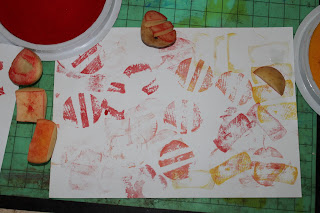
'Rapunzel's Supermarket' has a paragraph about colouring-in books which makes perfect sense to me, and which is why I cringe when I turn up at some library and playgroup events for children where the only 'creative' activity is for children to colour in pre-drawn sheets. I usually just turn the page over to the blank page and encourage Finn to draw his own lovely drawing (like shown above). To quote Ursula Kolbe on p. 118.
" It is sad when programs provide children with pre-drawn colouring in activities in the belief that these are 'educational'. Some claim that learning to colour within outlines helps children develop fine-muscle control and so assists them in gaining 'pre-writing'skills. That may be so, but why give children pre-drawn outlines to fill in?
When children are pleased with their own drawings, they usually take great care in colouring them in. Pride in their own drawings come from the confidence of knowing that they can draw. And confidence comes from having many opportunities to draw. If colouring-in activities are offered too frequently, children may miss opportunities to learn to draw. Less confident children may even lose faith in their drawing abilities. "
























